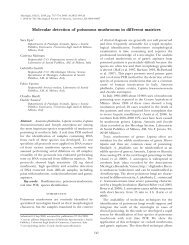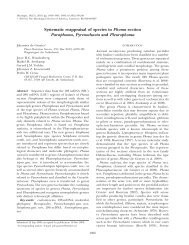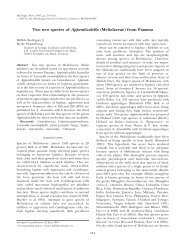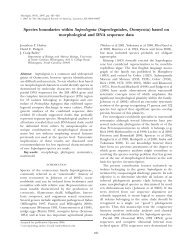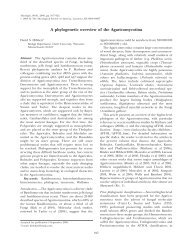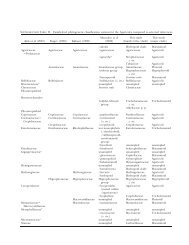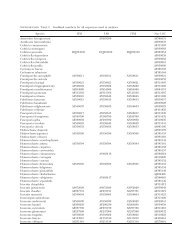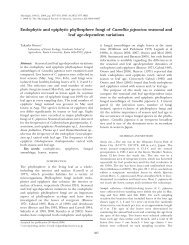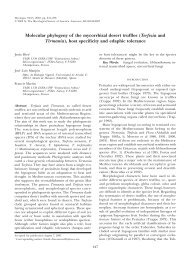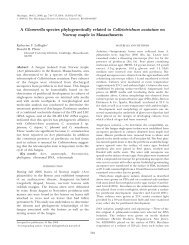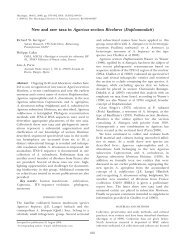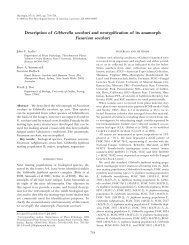Ocurrence of ectomycorrhizal, hypogeous fungi in ... - Mycologia
Ocurrence of ectomycorrhizal, hypogeous fungi in ... - Mycologia
Ocurrence of ectomycorrhizal, hypogeous fungi in ... - Mycologia
You also want an ePaper? Increase the reach of your titles
YUMPU automatically turns print PDFs into web optimized ePapers that Google loves.
<strong>Mycologia</strong>, 100(5), 2008, pp. 752–759. DOI: 10.3852/07-182<br />
# 2008 by The Mycological Society <strong>of</strong> America, Lawrence, KS 66044-8897<br />
<strong>Ocurrence</strong> <strong>of</strong> <strong>ectomycorrhizal</strong>, <strong>hypogeous</strong> <strong>fungi</strong> <strong>in</strong> plantations <strong>of</strong> exotic tree<br />
species <strong>in</strong> central Argent<strong>in</strong>a<br />
Eduardo R. Nouhra 1<br />
Laura S. Dom<strong>in</strong>guez<br />
Graciela G. Daniele<br />
Silvana Longo<br />
Instituto Multidiscipl<strong>in</strong>ario de Biología Vegetal<br />
(CONICET), Casilla de correo: 495, 5000, Córdoba,<br />
Argent<strong>in</strong>a<br />
James M. Trappe<br />
Department <strong>of</strong> Forest Science, Oregon State University,<br />
Corvallis, Oregon 97331-5752<br />
Andrew W. Claridge<br />
Department <strong>of</strong> Environment and Climate Change<br />
(NSW), Reserve Conservation Unit, Parks and Wildlife<br />
Division, Southern Branch, P.O. Box 2115,<br />
Queanbeyan, New South Wales 2620, Australia<br />
Abstract: Eleven <strong>hypogeous</strong>, <strong>ectomycorrhizal</strong> species<br />
<strong>of</strong> Basidiomycota, <strong>in</strong>clud<strong>in</strong>g two new species, and one<br />
<strong>of</strong> the Zygomycota were collected <strong>in</strong> exotic tree<br />
plantations <strong>in</strong> Córdoba Prov<strong>in</strong>ce, Argent<strong>in</strong>a. Descomyces<br />
fusisporus sp. nov., D. varians sp. nov.,<br />
Hydnangium archeri (Berk.) Rodway, H. carneum<br />
Wallr., Hysterangium gardneri E. Fisch. and Setchelliogaster<br />
tenuipes (Setch.) Pouzar were associated with<br />
Eucalyptus spp. Endogone lactiflua Berk., Hymenogaster<br />
lycoperd<strong>in</strong>eus Vittad., H. griseus Vittad., H.<br />
rehste<strong>in</strong>eri Bucholtz, Rhizopogon couchii A.H. Sm. and<br />
R. roseolus (Corda) Th. Fr., were associated with<br />
various northern hemisphere tree species. Descriptions<br />
are provided to aid identification <strong>of</strong> the<br />
<strong>hypogeous</strong> <strong>fungi</strong> <strong>in</strong> exotic plantations <strong>of</strong> Argent<strong>in</strong>a.<br />
Key words: Argent<strong>in</strong>a, Descomyces spp. nov.,<br />
mycorrhizal, sequestrate <strong>fungi</strong><br />
INTRODUCTION<br />
From the early 20th century to the present Eucalyptus,<br />
P<strong>in</strong>aceae and various northern hemisphere deciduous<br />
species have been planted extensively <strong>in</strong> Argent<strong>in</strong>a<br />
and elsewhere <strong>in</strong> the southern hemisphere (Dunstan<br />
et al 1998). In Córdoba Prov<strong>in</strong>ce <strong>of</strong> central Argent<strong>in</strong>a<br />
more than 41 000 ha have been planted with P<strong>in</strong>us<br />
elliottii, P. halepensis, P. patula, P. radiata and P. taeda<br />
(Izurieta et al 1998, Mangieri et al 1987) and<br />
approximately 4500 ha with E. camaldulensis, E.<br />
Accepted for publication 23 April 2008.<br />
1 Correspond<strong>in</strong>g author. E-mail: nouhra@imbiv.unc.edu.ar<br />
752<br />
sideroxylon, E. tereticornis and E. vim<strong>in</strong>alis (Golfari<br />
1985).<br />
Various <strong>hypogeous</strong>, <strong>ectomycorrhizal</strong> <strong>fungi</strong> were<br />
<strong>in</strong>troduced accidentally but fortuitously along with<br />
these economically important trees and became<br />
established <strong>in</strong> the exotic plantations as vital symbionts<br />
<strong>of</strong> the trees. The <strong>hypogeous</strong> truffles (Ascomycota)<br />
and ‘‘truffle-like <strong>fungi</strong>’’ (Basidiomycota and Zygomycota)<br />
comprised species with <strong>in</strong>dehiscent, sequestrate<br />
sporocarps conta<strong>in</strong><strong>in</strong>g statismosporic spores. With<strong>in</strong><br />
the Basidiomycota morphological and molecular<br />
studies have confirmed the polyphyletic orig<strong>in</strong> <strong>of</strong><br />
these <strong>fungi</strong>, and most species currently are placed <strong>in</strong><br />
recognized orders <strong>of</strong> epigeous mushrooms (Bruns et<br />
al 1998, Castellano and Beever 1994, Miller et al 2001,<br />
Pe<strong>in</strong>tner et al 2001, Thiers 1984).<br />
Meanwhile <strong>ectomycorrhizal</strong> <strong>fungi</strong> associated with<br />
P<strong>in</strong>aceae and Eucalyptus have been surveyed extensively<br />
elsewhere <strong>in</strong> the southern hemisphere (Birch<br />
1937, Chu-Chou 1979, Chu-Chou and Grace 1983,<br />
Dunstan et al 1998, Garrido 1986, Giach<strong>in</strong>i and<br />
Oliveira 1997, Giach<strong>in</strong>i et al 2000, Kessell 1927,<br />
Purnell 1957, Rawl<strong>in</strong>gs 1951). Only a few mycologists<br />
have paid attention to the <strong>hypogeous</strong> <strong>fungi</strong> <strong>of</strong><br />
Argent<strong>in</strong>a, especially those associated with native<br />
and exotic <strong>ectomycorrhizal</strong> hosts (Crespo and Domínguez<br />
1994, Lorenzo and Calvelo 2000, Nouhra and<br />
Becerra 2005, Romero and Blumenfield 2001, Spegazz<strong>in</strong>i<br />
1880, 1887, 1909, Wright 1980).<br />
The aim <strong>of</strong> the present study was to determ<strong>in</strong>e the<br />
exotic <strong>ectomycorrhizal</strong> <strong>hypogeous</strong> <strong>fungi</strong> associated<br />
with exotic, <strong>ectomycorrhizal</strong> plantations <strong>of</strong> Córdoba<br />
Prov<strong>in</strong>ce, Argent<strong>in</strong>a. New taxa are described <strong>in</strong> full.<br />
Short descriptions <strong>of</strong> previously described taxa,<br />
<strong>in</strong>clud<strong>in</strong>g diagnostically <strong>in</strong>formative macro- and<br />
microcharacters, are provided to aid identification<br />
by local mycologists.<br />
MATERIALS AND METHODS<br />
Study sites.—P<strong>in</strong>es and eucalypts plantations <strong>in</strong> Córdoba<br />
Prov<strong>in</strong>ce are located approx. at 31u209–32u409S and 62u009–<br />
64u509W. The weather <strong>in</strong> the region is characterized by<br />
mild, temperate summers and dry w<strong>in</strong>ters. Precipitation is<br />
concentrated Oct–Apr. Eucalypts plantations are better<br />
established <strong>in</strong> the eastern part <strong>of</strong> the prov<strong>in</strong>ce at lower<br />
altitudes up to 600 m. In this area precipitation is 600–<br />
900 mm (Vázquez et al 1979). Conifer plantations thrive<br />
best at higher altitudes, up to 1600 m <strong>in</strong> the mounta<strong>in</strong>s <strong>of</strong><br />
the west, where precipitation <strong>in</strong>creases up to 1200 mm
(Izurieta et al 1998). The two new species <strong>of</strong> Descomyces were<br />
discovered <strong>in</strong> Victoria and New South Wales, Australia,<br />
dur<strong>in</strong>g studies <strong>of</strong> <strong>hypogeous</strong> fungal diversity and habitat<br />
relationships (Claridge et al 2000a, b) but had not been<br />
described formally.<br />
Sporocarp sampl<strong>in</strong>g and sporocarp description.—Sporocarps<br />
were collected at random <strong>in</strong> the plantations and, <strong>in</strong> the case<br />
<strong>of</strong> the two new Descomyces spp., also <strong>in</strong> 1000 m 2 plots<br />
scattered over E Victoria and SE New South Wales (Claridge<br />
et al 2000a). Specimens usually were located by rak<strong>in</strong>g the<br />
soil litter and humus; occasional sporocarps were visible<br />
without rak<strong>in</strong>g, hav<strong>in</strong>g emerged from the soil. Most<br />
Argent<strong>in</strong>ean samples were collected Dec–Jun, the Australian<br />
samples <strong>of</strong> Descomyces Feb–Oct. Data on location and<br />
associated hosts are detailed for each species along with its<br />
description. Specimens were cut <strong>in</strong> half and, after notes on<br />
fresh characters were recorded, dried on a forced-air<br />
dehydrator at 640 C.<br />
Color, size, shape and other macrocharacters <strong>of</strong> fresh<br />
specimens were recorded, and most collections were<br />
photographed <strong>in</strong> surface and cross-sectional views. Color<br />
names <strong>of</strong> fresh and dry specimens are applied <strong>in</strong> general<br />
terms by the authors. Microcharacters were recorded from<br />
sections hand-cut from dried material, mounted respectively<br />
<strong>in</strong> water, 5% KOH, Melzer’s reagent, cotton blue and<br />
phlox<strong>in</strong>e for standard light microscopy. Spore dimensions<br />
are based on the measurement <strong>of</strong> at least 15 randomly<br />
selected, plus largest and smallest spores, <strong>in</strong>clud<strong>in</strong>g<br />
ornamentation. Measurements <strong>of</strong> tissues and spores are<br />
from mature specimens; when two dimensions are given,<br />
length always precedes width.<br />
Specimens are deposited as <strong>in</strong>dicated <strong>in</strong> the Museo<br />
Botánico de Córdoba (CORD), Mycological Herbarium <strong>of</strong><br />
Oregon State University (OSC), National Herbarium <strong>of</strong><br />
Victoria (MEL) or the Plant Pathology Herbarium, Orange<br />
Agricultural Institute, New South Wales (DAR). Identification<br />
was aided by keys and specific references (Beaton et al<br />
1984, Bougher and Castellano 1993, Castellano et al 1989,<br />
Miller 1986, Montecchi and Lazzari 1993, Montecchi and<br />
Saras<strong>in</strong>i 2000, Trappe unpubl).<br />
TAXONOMY<br />
Associates <strong>of</strong> Eucalyptus.—Descomyces fusisporus<br />
Trappe & Claridge, sp. nov. FIG. 1A<br />
Peridium 100–350 mm crassum; pellis albis hyphis <strong>in</strong>tertextis,<br />
juventute suprapelle lutea vel luteobrunnea. Gleba<br />
loculata, tabac<strong>in</strong>a, <strong>in</strong>terdum columella truncata alba vel<br />
pallide brunnea. Basidia 35–40 3 8–10 mm, clavata, sterigmatibus<br />
duobus. Sporae brunneae, fusoides-citriformes,<br />
papillatae, 17–23 3 9–12 mm, reticulo partiali vel completo,<br />
m<strong>in</strong>ute labyr<strong>in</strong>thiformi 0.5 mm alto ornatae; sporae <strong>in</strong><br />
solutione Melzeri juventute rubrae, maturitate pallide<br />
aurantiae. Holotypus hic designatus: A.W. Claridge AWC<br />
349.<br />
Basidiomata globose, subglobose to irregular, 5–11<br />
3 5–20 mm. Peridium with a white pellis, <strong>in</strong> youth<br />
covered by a loose to appressed, yellow, veil-like<br />
suprapellis that th<strong>in</strong>s as basidiomata expand to<br />
NOUHRA ET AL: EXOTIC HYPOGEOUS FUNGI IN ARGENTINA 753<br />
produce an overall pale yellow to cream color or<br />
breaks up to reveal the white pellis with only scattered<br />
patches <strong>of</strong> suprapellis; <strong>in</strong> age all peridial tissues tend<br />
to darken. Gleba loculate, white <strong>in</strong> youth, by maturity<br />
c<strong>in</strong>namon to dark brown, occasionally with a truncate<br />
columella up to 3 mm broad.<br />
Peridium 100–350 mm thick; suprapellis <strong>of</strong> tangled,<br />
hyal<strong>in</strong>e to yellow or light yellowish brown, septate,<br />
th<strong>in</strong> walled hyphae 3–7 mm broad at the septa, the<br />
cells <strong>of</strong>ten somewhat <strong>in</strong>flated; pellis <strong>of</strong> pericl<strong>in</strong>al to<br />
<strong>in</strong>terwoven, th<strong>in</strong>-walled, hyal<strong>in</strong>e hyphae 3–5 mm<br />
broad with occasional, slightly <strong>in</strong>flated cells; clamp<br />
connections abundant, <strong>in</strong>conspicuous. Trama <strong>of</strong><br />
subparallel, th<strong>in</strong>-walled hyal<strong>in</strong>e hyphae, 3–5 mm broad<br />
with occasional <strong>in</strong>flated cells. Subhymenium not<br />
differentiated from the trama. Basidia hyal<strong>in</strong>e, th<strong>in</strong>walled,<br />
clavate, 35–40 3 8–10 mm, with two robust<br />
sterigmata.<br />
Spores brown, fusoid-citriform, papillate, with a<br />
prom<strong>in</strong>ent sterigmal attachment, 17–23 3 9–12 mm<br />
(Q 5 1.7–2.2) <strong>in</strong>clud<strong>in</strong>g the ornamentation 0.5 mm<br />
tall <strong>of</strong> a m<strong>in</strong>ute, partial to complete, labyr<strong>in</strong>thiform<br />
reticulum; apical papilla 1–4 3 3–4 mm, smooth,<br />
usually dark brown <strong>in</strong> youth, later fad<strong>in</strong>g to pale<br />
brown; sterigmal attachment 3 31.5–2 mm; spores <strong>in</strong><br />
KOH yellowish brown, <strong>in</strong> Melzer’s reagent red<br />
(strongly dextr<strong>in</strong>oid) <strong>in</strong> youth, at maturity light<br />
orange (weakly dextr<strong>in</strong>oid).<br />
Etymology. Lat<strong>in</strong> fusisporus <strong>in</strong> reference to the<br />
fusoid-citriform spores.<br />
Distribution, habitat, hosts and season. In Argent<strong>in</strong>a<br />
<strong>in</strong> soil and leaf litter <strong>in</strong> a plantation <strong>of</strong> Eucalyptus<br />
c<strong>in</strong>erea, May. In Australia <strong>in</strong> gully bottoms and on<br />
sheltered slopes and ridges <strong>in</strong> mixed, natural, wet,<br />
montane forests consist<strong>in</strong>g <strong>of</strong> various mixtures <strong>of</strong><br />
Acacia dealbata, A. implexa, A. melanoxylon, Eucalyptus<br />
dalrympleana, E. fastigata, E. nitens, E. pauciflora, E.<br />
radiata, E. stellulata and E. vim<strong>in</strong>alis; Apr, May and<br />
Jun.<br />
HOLOTYPE. AUSTRALIA: VICTORIA: Rich Forest<br />
Management Block, Jack Road 0.7 km N <strong>of</strong> W<strong>in</strong>ter Road,<br />
17 Apr 1996, A.W.Claridge, AWC 349 ( MEL, OSC).<br />
Specimens exam<strong>in</strong>ed. ARGENTINA: CÓRDOBA: Punilla,<br />
Establecimiento Ayke, 3 km S <strong>of</strong> Cuesta Blanca, 18 May<br />
2002, L. Domínguez 2224 (CORD, OSC). AUSTRALIA:<br />
VICTORIA: East Gippsland, Alp<strong>in</strong>e National Park, Black<br />
Mounta<strong>in</strong> Road 3.2 km E. <strong>of</strong> Rams Horn Track, A.W.<br />
Claridge and W. Colgan III, 14 May 2001, AWC 3329 (MEL,<br />
OSC); Bentleigh Pla<strong>in</strong>s Forest Reserve, Bentleigh Creek<br />
0.4 km NE <strong>of</strong> cross<strong>in</strong>g <strong>of</strong> Bentleigh Pla<strong>in</strong>s Road, A. Giach<strong>in</strong>i,<br />
18 May 2001, AWC 3619.2 (MEL, ISOTYPE. OSC);<br />
Err<strong>in</strong>undra National Park, Gunmark Road 1.3 km SE <strong>of</strong><br />
Survey Road, J. Trappe, A.W. Claridge and A. Jumpponen, 26<br />
May 2001, AWC 4041 (MEL, OSC); Gunmark Road 1.6 km<br />
SE <strong>of</strong> Junction Survey Road, W. Colgan III, 26 May 2001,<br />
AWC 4092 (MEL, OSC); Gunmark Road 2.3 km SE <strong>of</strong> Tea
754 MYCOLOGIA<br />
FIG. 1. A.Descomyces fusisporus sp. nov., basidiospores. B–D. Descomyces varians sp. nov. B. Basidiospores. C. Basidiomata.<br />
D. Peridial polycystoderm. Bar: A, B 5 10 mm; C 5 5 mm; D 5 15 mm.<br />
Tree Flat Picnic Area, J. Trappe, A.W. Claridge and A.<br />
Jumpponen, 11 Jun 1996, Trappe 19455 (MEL, OSC); Coast<br />
Range Road at Goonmirk Rocks Road, A. Giach<strong>in</strong>i, 26 May<br />
2001, AWC 4068 (MEL, OSC); Rich Forest Management<br />
Block, Jack Road 0.7 km N <strong>of</strong> W<strong>in</strong>ter Road, 17 Apr 1996,<br />
AWC 348 & 351, (MEL, OSC); Gap Scenic Reserve, Gap<br />
Road 5.2 km E <strong>of</strong> Bonang Highway, 27 May 1999, AWC<br />
2603.2 (MEL, OSC).<br />
Comments. Descomyces fusisporus as presently known<br />
has a relatively small distribution <strong>in</strong> Australia, limited<br />
to wet, montane forests <strong>in</strong> East Gippsland, Victoria. It<br />
differs from all other species <strong>in</strong> the genus by its<br />
comb<strong>in</strong>ation <strong>of</strong> fusoid-citriform spores ornamented<br />
with a partial to complete, low, labyr<strong>in</strong>thiform<br />
reticulum and a brown apical papilla <strong>in</strong> youth, plus<br />
lack <strong>of</strong> a peridial epithelium <strong>of</strong> <strong>in</strong>flated cells. D.<br />
giach<strong>in</strong>ii Trappe et al, <strong>in</strong>troduced to Brazil with<br />
eucalypts, has a much broader distribution and range<br />
<strong>of</strong> habitats (Giach<strong>in</strong>i et al 2000). Its spores on average<br />
are more broadly citriform than those <strong>of</strong> D. fusisporus<br />
and the ornamentation is a reticulum 1 mm tallthat<br />
tends to be alveolate <strong>in</strong>stead <strong>of</strong> labyr<strong>in</strong>thiform.<br />
Descomyces varians Trappe & Claridge, sp. nov.<br />
FIG. 1B–D<br />
Peridium 100–300 mm crassum; pellis albis hyphis <strong>in</strong>tertextis,<br />
juventute suprapelle lutea vel luteobrunnea. Gleba<br />
loculata, tabac<strong>in</strong>a. Basidia 25–30 3 6–7 mm, clavata,<br />
sterigmatibus duobus. Sporae brunneae, citriformes, papil-
latae, 11–16 3 9–12 mm, reticulo partiali vel completo,<br />
m<strong>in</strong>ute labyr<strong>in</strong>thiformi 0.5–1(–1.5) mm alto cum verrucis<br />
irregularibus et cristis brevibus ornatae; sporae <strong>in</strong> solutione<br />
Melzeri juventute rubrae, maturitate pallide aurantiae.<br />
Basidiomata globose, subglobose to irregular, 5–15<br />
3 5–20 mm. Peridium with a white pellis, <strong>in</strong> youth<br />
covered by a yellow, loose to appressed suprapellis<br />
that th<strong>in</strong>s with expansion <strong>of</strong> the basidiomata to<br />
produce a pale yellow to cream color or breaks up<br />
to reveal the white pellis with only scattered patches <strong>of</strong><br />
suprapellis; <strong>in</strong> age all peridial tissues tend to become<br />
yellowish brown. Gleba loculate, pale cream <strong>in</strong> youth,<br />
by maturity c<strong>in</strong>namon to dark brown.<br />
Peridium 100–300 mm thick; suprapellis <strong>of</strong> hyal<strong>in</strong>e<br />
to yellow or light yellowish brown, septate, th<strong>in</strong>- to<br />
thick-walled hyphae 3–7 mm broad at the septa, the<br />
cells <strong>of</strong>ten somewhat <strong>in</strong>flated; pellis a well developed<br />
to broken polycystoderm <strong>of</strong> th<strong>in</strong>-walled, vesiculose<br />
cells 10–25 3 10–30 mm; subpellis <strong>of</strong> hyal<strong>in</strong>e, <strong>in</strong>terwoven<br />
hyphae; clamp connections abundant, <strong>in</strong>conspicuous.<br />
Trama <strong>of</strong> hyal<strong>in</strong>e, subparallel hyphae 2–<br />
5 mm broad at the septa, many cells <strong>in</strong>flated.<br />
Subhymenium <strong>of</strong> hyal<strong>in</strong>e, <strong>in</strong>terwoven hyphae 2–<br />
3 mm broad. Basidia 2-spored, hyal<strong>in</strong>e, clavate, 25–30<br />
3 6–7 mm.<br />
Spores broadly citriform, papillate, with a prom<strong>in</strong>ent<br />
sterigmal attachment, 11–16 3 6.5–11 mm<br />
exclud<strong>in</strong>g ornamentation (Q 5 1.3–1.6), 12–16<br />
(–17) 3 9–11(–12) mm <strong>in</strong>clud<strong>in</strong>g the ornamentation,<br />
0. 5–1(–1.5) mm tall (<strong>of</strong>ten tallest near the spore base)<br />
<strong>of</strong> a m<strong>in</strong>ute, partial to complete, labyr<strong>in</strong>thiform<br />
reticulum or irregular warts and short ridges; apical<br />
papilla 1–2 3 3 mm, smooth; sterigmal attachment 2<br />
3 2 mm; spores <strong>in</strong> KOH yellowish brown, <strong>in</strong> Melzer’s<br />
reagent red (strongly dextr<strong>in</strong>oid) <strong>in</strong> youth, at<br />
maturity light orange (weakly dextr<strong>in</strong>oid).<br />
Etymology. Lat<strong>in</strong> varians (vary<strong>in</strong>g), <strong>in</strong> reference to<br />
the variable development <strong>of</strong> the polycystoderm epithelium<br />
and spore ornamentation.<br />
Distribution, habitat, hosts and season. Central Argent<strong>in</strong>a,<br />
under a thick litter layer <strong>in</strong> a plantation <strong>of</strong><br />
Eucalyptus camaldulensis, May. Southeastern Australia,<br />
<strong>in</strong> dry to wet sclerophyllous forests <strong>in</strong> mixed stands<br />
variously conta<strong>in</strong><strong>in</strong>g Acacia longifolia, A. mearnsii, A.<br />
melanoxylon, A. mucronata, Angophora floribunda,<br />
Eucalyptus albens, E. botryoides, E. cypellocarpa, E.<br />
globoidea, E. longifolia, E. microcarpa, E. muelleriana,<br />
E. obliqua, May–Oct.<br />
HOLOTYPE: AUSTRALIA: VICTORIA: Murrangowar<br />
Forest Management Block, Pr<strong>in</strong>ces Highway 0.4 km E <strong>of</strong><br />
Bendoc Ridge Road. A.W. Claridge, J. Trappe & T. Lebel, 26<br />
May 1999, AWC 2555 (MEL; OSC).<br />
Specimens exam<strong>in</strong>ed. ARGENTINA: CÓRDOBA: Calamuchita,<br />
Villa Alp<strong>in</strong>a, L. Domínguez, 12 May 2001, LSD<br />
2002 (CORD); 11 km before La Cumbrecita, L. Domínguez,<br />
14 May 2002, LSD 2209 & LSD 2214 (CORD). AUSTRA-<br />
NOUHRA ET AL: EXOTIC HYPOGEOUS FUNGI IN ARGENTINA 755<br />
LIA, NEW SOUTH WALES: Ben Boyd National Park,<br />
Bittangabee Bay, at walk<strong>in</strong>g track cross<strong>in</strong>g <strong>of</strong> Bittangabee<br />
Creek, A.W. Jumpponen, 2 Jun 1999, AWC 3052 (DAR,<br />
OSC); Nadgee State Forest, M<strong>in</strong>es Forest Road 1.2 km W. <strong>of</strong><br />
Buckland Road, A. Giach<strong>in</strong>i & A.W. Claridge, 31 May 2001,<br />
AWC 4431 (OSC). VICTORIA: East Gippsland: Cabbage<br />
Tree Forest Management Block, Towser L<strong>in</strong>k Track 0.7 m S<br />
<strong>of</strong> Douthat Road, A.W. Claridge, 10 Oct 1995, AWC 49 &<br />
51 (MEL, OSC); Omeo Highway, 2 km S <strong>of</strong> Ash Range<br />
Road, A.W. Claridge, 21 May 1999, AWC 2378 (MEL, OSC);<br />
Rich Forest Management Block, Puggaree Road at Arte<br />
Shortcut Road, A.W. Claridge, 27 Feb 1996, AWC 160<br />
(MEL, OSC).<br />
Comments. Descomyces varians differs from D. giach<strong>in</strong>ii<br />
Trappe et al (Giach<strong>in</strong>i et al 2000) by hav<strong>in</strong>g a<br />
polycystoderm epithelium and generally smaller<br />
spores with a lower ornamentation. This pair <strong>of</strong><br />
species is analogous to the D. albus and D. albellus<br />
pair, which do not have partially to fully reticulate<br />
spores and differ primarily by D. albus hav<strong>in</strong>g a<br />
polycystoderm epithelium and D. albellus lack<strong>in</strong>g that<br />
(Bougher and Castellano 1993). All Descomyces spp.<br />
appear to have orig<strong>in</strong>ated <strong>in</strong> Australia as mycorrhizal<br />
associates <strong>of</strong> Eucalyptus spp., and many probably were<br />
<strong>in</strong>troduced as hitch-hikers on roots <strong>of</strong> eucalypt<br />
seedl<strong>in</strong>gs shipped from Australia to other cont<strong>in</strong>ents.<br />
Most also appear adapted to a wide range <strong>of</strong> tree ages<br />
and habitats.<br />
Hydnangium archeri (Berk.) Rodway<br />
Basidiomata ellipsoid, usually basally depressed<br />
with a hyphal basal attachment, 25 3 20 mm.<br />
Peridium yellowish brown, th<strong>in</strong>, 60–100 mm thick,<br />
composed <strong>of</strong> <strong>in</strong>terwoven strands <strong>of</strong> parallel hyphae up<br />
to 16 mm thick. Gleba whitish to cream, not gelat<strong>in</strong>ized,<br />
with small irregular chambers and a narrow<br />
columella. Hymenium, a palisade <strong>of</strong> cyl<strong>in</strong>drical to<br />
clavate basidia, bear<strong>in</strong>g two large straight sterigmata.<br />
Spores globose, hyal<strong>in</strong>e, (9–)10.5–14(–15.5) mm diam,<br />
ornamented with conical sp<strong>in</strong>es 1.5–2.5(–3.5) 3 0.2–<br />
2 mm. Clamp connections present.<br />
Habitat, hosts and season. Hypogeous under a thick<br />
organic layer, on top <strong>of</strong> the m<strong>in</strong>eral soil, <strong>in</strong> plantation<br />
<strong>of</strong> E. camaldulensis, May<br />
Specimens exam<strong>in</strong>ed. ARGENTINA: CÓRDOBA: Calamuchita,<br />
Villa Alp<strong>in</strong>a, L. Domínguez, 20 May 2001, LSD<br />
2204 (CORD, OSC).<br />
Comments. Basidiomata <strong>of</strong> H. archeri are yellowish<br />
brown and its spores are smaller but have larger sp<strong>in</strong>es<br />
than the p<strong>in</strong>k to rose H. carneum (Beaton et al 1984).<br />
It is <strong>in</strong>frequent <strong>in</strong> native Eucalyptus forests <strong>of</strong> Australia.<br />
Hydnangium carneum Wallr.<br />
Basidiomata globose, subglobose, depressed or<br />
irregular, 10–25 mm broad. Peridium p<strong>in</strong>kish white
756 MYCOLOGIA<br />
or rose when fresh, dry<strong>in</strong>g tan to brownish, up to<br />
300 mm thick, <strong>of</strong> clamped, cyl<strong>in</strong>drical hyphae <strong>in</strong>term<strong>in</strong>gled<br />
with sphaerocysts and some <strong>in</strong>flated hyphae.<br />
Gleba p<strong>in</strong>kish white, fad<strong>in</strong>g whitish, then tan when<br />
dry, <strong>of</strong> labyr<strong>in</strong>thiform chambers; a small columella<br />
and a sterile basal pad usually present. Spores<br />
globose, hyal<strong>in</strong>e, 12–17 mm broad exclud<strong>in</strong>g the<br />
ornamentation <strong>of</strong> sp<strong>in</strong>es and narrow cones 1.5–2 3<br />
0.5–2 mm.<br />
Habitat, hosts and season. Hypogeous under a thick<br />
layer <strong>of</strong> leaves and debris <strong>in</strong> plantation <strong>of</strong> E.<br />
camaldulensis, May and Nov.<br />
Specimens exam<strong>in</strong>ed. ARGENTINA: CÓRDOBA: Calamuchita,<br />
11 km before La Cumbrecita, L. Domínguez, 14<br />
May 2002, LSD 2212 (CORD); Estancia Alta Vista, Atos<br />
Pampa, L. Domínguez, 14 May 2002, LSD 2208 (CORD);<br />
Villa Alp<strong>in</strong>a, L. Domínguez, 17 Nov 1997, LSD 2294<br />
(CORD). Colón: Estancia Santo Dom<strong>in</strong>go, L. Domínguez,<br />
30 May 1997, LSD 2295 (CORD).<br />
Comments. Among the more widely distributed and<br />
common <strong>hypogeous</strong> <strong>fungi</strong> <strong>of</strong> eucalypts <strong>in</strong> Australia,<br />
this species has been dispersed around the world with<br />
eucalypts. We have found it fruit<strong>in</strong>g <strong>in</strong> enormous<br />
numbers <strong>in</strong> plantations <strong>in</strong> California.<br />
Hysterangium gardneri E. Fisch.<br />
Basidiomata subglobose to irregular, 0.5–2 cm<br />
broad; rhizomorphs white, well developed at the base<br />
and sides <strong>of</strong> basidiomata, abundant with<strong>in</strong> the<br />
substrate. Peridium smooth, somewhat rubbery when<br />
fresh, white to light brown, bruis<strong>in</strong>g pale p<strong>in</strong>k to<br />
p<strong>in</strong>kish brown, dry<strong>in</strong>g pale brown, 400–600 mm thick,<br />
<strong>of</strong> cyl<strong>in</strong>drical yellow hyphae, 2–7 mm broad at the<br />
septa, many cells <strong>in</strong>flated up to 15 mm, with crystals<br />
adher<strong>in</strong>g to the surface; clamp connections scattered,<br />
<strong>in</strong>conspicuous. Gleba olive green to grayish green,<br />
dry<strong>in</strong>g dark green, with elongate locules and a<br />
cartilag<strong>in</strong>ous, dendroid, translucent columella.<br />
Spores ellipsoid with a truncate base, 8–10.5 3 3–<br />
4 mm, surface smooth but enclosed <strong>in</strong> an irregular,<br />
tightly adherent to wr<strong>in</strong>kled exosporium. Basidia<br />
hyal<strong>in</strong>e, cyl<strong>in</strong>drical, mostly 6-spored.<br />
Habitat, host and season. Hypogeous <strong>in</strong> soil under<br />
leaves and litter <strong>in</strong> mixed plantation <strong>of</strong> Eucalyptus<br />
c<strong>in</strong>erea and E. camaldulensis. Some basidomata were<br />
emergent <strong>in</strong> exposed soil, May.<br />
Specimens exam<strong>in</strong>ed. ARGENTINA: CÓRDOBA: Calamuchita,<br />
11 km before La Cumbrecita, L. Domínguez, 14<br />
May 2002, LSD 2210 & 2211 (CORD, OSC). Punilla,<br />
Establecimiento Ayke, 3 km south <strong>of</strong> Cuesta Blanca, L.<br />
Domínguez, 18 May 2002, LSD 2222 (CORD).<br />
Comments. The spore size and abundance <strong>of</strong> hyphae<br />
and rhizomorphs adher<strong>in</strong>g to the sides and the<br />
base <strong>of</strong> the basidiomata, differentiate H. gardneri from<br />
other Eucalyptus associated Hysterangium spp. known<br />
at present, although the genus has not been studied<br />
fully <strong>in</strong> Australia. The variation <strong>of</strong> shape and size <strong>of</strong><br />
peridial hyphae can be mis<strong>in</strong>terpreted as a multilayered<br />
structure. H. gardneri is common and widely<br />
distributed <strong>in</strong> Australia and occurs <strong>in</strong> Eucalyptus<br />
plantations around the world.<br />
Setchelliogaster tenuipes (Setch.) Pouzar.<br />
Basidiomata up to 2.5 cm broad; pileus globose to<br />
subglobose, stipitate, rem<strong>in</strong>iscent <strong>of</strong> an unexpanded<br />
agaric with the marg<strong>in</strong> attached to the stipe. Peridium<br />
smooth, dry and glabrous, reddish brown to orange<br />
brown, up to 300 mm thick, the pellis an epithelium <strong>of</strong><br />
ellipsoid to subglobose or pyriform, hyal<strong>in</strong>e cells.<br />
Stipe, cyl<strong>in</strong>dric, 1–3 cm long, solid, white to creamy<br />
white. Gleba with elongated chambers radiat<strong>in</strong>g from<br />
the stipe columella, concolorous with the peridium or<br />
paler. Basidia 2-spored. Spores asymmetric, citriform,<br />
yellowish brown, 8–9.5 313–14.5 mm, f<strong>in</strong>ely verrucose,<br />
with an apical papilla, lack<strong>in</strong>g a germ pore.<br />
Habitat, host and season. Sub<strong>hypogeous</strong> under litter<br />
<strong>in</strong> E. camaldulensis plantation, May.<br />
Specimens exam<strong>in</strong>ed. ARGENTINA: CÓRDOBA: Calamuchita,<br />
11 km before La Cumbrecita, L. Domínguez, 14<br />
May 2001, LSD 2215; same locality, L. Domínguez, 20 May<br />
2002, LSD 2207 (CORD).<br />
Comments. This taxon is widespread <strong>in</strong> Australia<br />
and has been collected <strong>in</strong> Argent<strong>in</strong>a (Patagonia and<br />
Buenos Aires), Uruguay and North America under E.<br />
globulus (Setchell 1907, Wright 1980).<br />
Associates <strong>of</strong> P<strong>in</strong>us and various northern hemisphere<br />
deciduous trees.—Endogone lactiflua Berk. & Broome.<br />
Zygomata subglobose to ellipsoid, reniform or<br />
irregular, up to 9 3 14 mm, <strong>of</strong>ten with a basal<br />
attachment to the soil, exud<strong>in</strong>g a sticky white fluid <strong>in</strong><br />
cut surfaces <strong>of</strong> fresh, young specimens. Peridium th<strong>in</strong>,<br />
white to cream, partially to completely disappear<strong>in</strong>g<br />
<strong>in</strong> old specimens. Gleba <strong>of</strong>ten with a small, sterile,<br />
basal pad at the base, with uniformly distributed<br />
spores. Spores globose to ellipsoid, light yelloworange,<br />
70–180 3 94–190 mm, the wall 5–10 mm thick,<br />
consist<strong>in</strong>g <strong>of</strong> a yellow lam<strong>in</strong>ar <strong>in</strong>ner wall up to 8 mm<br />
thick, and a th<strong>in</strong> outer wall 1–3 mm that sta<strong>in</strong>s reddish<br />
brown <strong>in</strong> Melzer’s reagent. Mature spores are<br />
enclosed <strong>in</strong> hyphal mantles composed <strong>of</strong> several<br />
layers <strong>of</strong> th<strong>in</strong>-walled, yellow, much <strong>in</strong>terwoven hyphae<br />
that at maturity become orange to red <strong>in</strong> Melzer’s<br />
reagent. Gametangia up to 65(–80) mm broad, long<br />
persistent.<br />
Habitat, host and season. Hypogeous, under P<strong>in</strong>us<br />
elliottii and P. taeda, Apr.<br />
Specimens exam<strong>in</strong>ed. ARGENTINA: CÓRDOBA: Calamuchita,<br />
15 km before Villa Alp<strong>in</strong>a, L Domínguez, 8 Apr<br />
1999, LSD 2231 (CORD, OSC).
Comments. A cosmopolitan <strong>ectomycorrhizal</strong> fungus<br />
<strong>in</strong> the northern hemisphere, E. lactiflua is common <strong>in</strong><br />
conifer forest nurseries (Fassi et al 1969) and has been<br />
<strong>in</strong>troduced widely <strong>in</strong> conifer plantations <strong>in</strong> the<br />
southern hemisphere.<br />
Hymenogaster griseus Vittad.<br />
Basidiomata globose to irregular, up to 2 cm diam.<br />
Peridium white, bruis<strong>in</strong>g ochraceous, thick, 380–<br />
500 mm, not separable, the pellis <strong>of</strong> cyl<strong>in</strong>drical,<br />
septate, th<strong>in</strong>-walled hyphae 3–5 mm broad, grad<strong>in</strong>g<br />
<strong>in</strong>to a pseudoparenchymatous subpellis toward the<br />
gleba. Gleba loculate, labyr<strong>in</strong>thiform, with a small<br />
sterile base, whitish to pale ochraceous, dry<strong>in</strong>g brown<br />
to rusty brown; trama <strong>of</strong> <strong>in</strong>flated cells. Spores<br />
ellipsoid, citriform to obovate, 13–20 3 8–11 mm,<br />
with an <strong>in</strong>conspicuous apical papilla; perisporium<br />
closely appressed, wr<strong>in</strong>kled-verrucose; apiculus short.<br />
Habitat, host and season. Central Argent<strong>in</strong>a, <strong>hypogeous</strong><br />
<strong>in</strong> organic soil, under litter <strong>of</strong> P<strong>in</strong>us and Cedrus<br />
spp., Dec–Mar.<br />
Specimens exam<strong>in</strong>ed. ARGENTINA: CÓRDOBA: Calamuchita,<br />
Atos Pampa, L. Domínguez, 8 Mar 1995, LSD<br />
1410 (CORD, OSC); La Cumbrecita, E. Nouhra & E.<br />
Crespo, 9 Dec 1993, LSD 1405 (CORD, OSC).<br />
Hymenogaster lycoperd<strong>in</strong>eus Vittad.<br />
Basidiomata subglobose to irregular, 1–3 cm broad.<br />
Peridium 200–300 mm thick, not separable, smooth,<br />
white to yellowish white at base grad<strong>in</strong>g to light<br />
yellowish brown or light brown toward the top,<br />
darken<strong>in</strong>g when bruised, the pellis <strong>of</strong> cyl<strong>in</strong>drical,<br />
th<strong>in</strong>-walled hyphae grad<strong>in</strong>g to a subpellis <strong>of</strong> <strong>in</strong>flated,<br />
subglobose cells. Gleba loculate, lack<strong>in</strong>g a columella<br />
or sterile base, white <strong>in</strong> youth, by maturity darkened<br />
to brown. Odor strong, rancid. Spores ellipsoid to<br />
fusoid, 15–25 3 9.5–14.5 mm, apical papilla conspicuous<br />
or occasionally low and rounded; perisporium<br />
closely appressed, wr<strong>in</strong>kled <strong>in</strong>to small folds and warts.<br />
Habitat, host and season. Hypogeous, under litter <strong>of</strong><br />
P<strong>in</strong>us sp. and Cedrus sp., May.<br />
Specimens exam<strong>in</strong>ed. ARGENTINA: CÓRDOBA: Calamuchita,<br />
Atos Pampa, L. Domínguez, 14 May 2002, LSD<br />
2217, LSD 2218 & LSD 2220 (CORD).<br />
Hymenogaster rehste<strong>in</strong>eri Bucholtz<br />
Basidiomata subglobose to irregular, 0.3–2 cm<br />
broad. Peridium up to 270 mm thick, whitish, f<strong>in</strong>ally<br />
pale yellow to brownish gray, becom<strong>in</strong>g dark brown<br />
where bruised, with a pellis <strong>of</strong> hyal<strong>in</strong>e, cyl<strong>in</strong>drical<br />
hyphae and a subpellis <strong>of</strong> mostly pseudoparenchymatous<br />
hyphae. Gleba with irregular to elongated<br />
locules, sometimes with a small sterile base, <strong>in</strong> youth<br />
white, at maturity dark brown. Odor <strong>of</strong> dried<br />
NOUHRA ET AL: EXOTIC HYPOGEOUS FUNGI IN ARGENTINA 757<br />
specimens, strong. Spores fusiform to somewhat<br />
variable, 15–25(–30) 3 8–13 mm, with a conspicuous<br />
papilla; perisporium fairly closely appressed, wr<strong>in</strong>kled,<br />
verrucose, arranged <strong>in</strong>to small longitud<strong>in</strong>al<br />
folds, and crests; apiculus evident.<br />
Habitat, host and season. Hypogeous <strong>in</strong> soil, under<br />
forest litter <strong>in</strong> various mixtures <strong>of</strong> P<strong>in</strong>us, Betula,<br />
Quercus and Tilia spp., sometimes <strong>in</strong>clud<strong>in</strong>g Eucalyptus,<br />
Nov–Jun.<br />
Specimens exam<strong>in</strong>ed. ARGENTINA: CÓRDOBA: Calamuchita,<br />
Villa Alp<strong>in</strong>a, L. Domínguez, 17 Nov 1997, LSD<br />
2298 & LSD 2296 (CORD, OSC); La Cumbrecita, E.<br />
Nouhra, 9 Dec 1993, LSD 1406 (CORD); same locality, L.<br />
Domínguez, 9 Jun 1995, LSD 2299 (CORD).<br />
Rhizopogon couchii A.H. Sm.<br />
Basidiomata up to 60 mm diam, subglobose,<br />
rhizomorphs appressed to the peridium and abundant<br />
<strong>in</strong> soil. Peridium smooth, up to 300 mm thick,<br />
subtomentose, whitish yellow to yellow, yellow ve<strong>in</strong>s<br />
present, then yellowish brown, spotted red or<br />
brownish red, some sporocarps bruis<strong>in</strong>g v<strong>in</strong>aceous.<br />
Peridium characterized by a cutis constituted by<br />
tightly <strong>in</strong>terwoven cyl<strong>in</strong>drical th<strong>in</strong>-walled hyphae.<br />
Gleba loculate, s<strong>of</strong>t when young, then firm, cartilag<strong>in</strong>ous,<br />
f<strong>in</strong>ally dry, whitish to yellowish brown, yellowish<br />
gray. Spores subcyl<strong>in</strong>drical, elliptical, smooth, not<br />
truncate, 6–8 3 2–2.5 mm. Brachybasidioles present <strong>in</strong><br />
hymenium, subglobose, to ovate, th<strong>in</strong>-walled when<br />
young, then moderately thick-walled, not disarticulat<strong>in</strong>g.<br />
Habitat, host and season. Hypogeous <strong>in</strong> soil, not<br />
common, underneath leaves and litter <strong>in</strong> P. elliottii<br />
plantation, May.<br />
Specimens exam<strong>in</strong>ed. ARGENTINA: CÓRDOBA: Calamuchita,<br />
Villa Alp<strong>in</strong>a, L. Domínguez, 12 May 2001, LSD<br />
2205 (CORD, OSC).<br />
Rhizopogon roseolus Corda<br />
Basidiomata up to 4 cm broad, subglobose to<br />
turb<strong>in</strong>ate, rhizomorphs appressed overall and abundant<br />
<strong>in</strong> soil. Peridium smooth, 0.5–1 mm thick,<br />
fibrillose, white to yellow <strong>in</strong> youth, soon becom<strong>in</strong>g<br />
yellowish brown to reddish brown, bruis<strong>in</strong>g brownish<br />
red to v<strong>in</strong>aceous; KOH reddish brown on peridium.<br />
Gleba loculate, s<strong>of</strong>t, dry<strong>in</strong>g hard, yellowish <strong>in</strong> youth,<br />
at maturity brown to olive brown, sometimes with a<br />
small basal pad. Spores smooth, subfusoid to broadly<br />
ellipsoid, truncate, 6–12 3 3.5–4 mm. Brachybasidioles<br />
present <strong>in</strong> hymenium, subglobose, clavate,<br />
obovate, 20–25 3 8–12 mm, easily disarticulat<strong>in</strong>g.<br />
Habitat, host and season. Hypogeous to sub<strong>hypogeous</strong><br />
<strong>in</strong> soil, common <strong>in</strong> P. elliottii, P. radiata and P.<br />
taeda plantations, Apr and May.<br />
Specimens exam<strong>in</strong>ed. ARGENTINA: CÓRDOBA: Cala-
758 MYCOLOGIA<br />
muchita, Villa Alp<strong>in</strong>a, Estancia La Payana, M. Evdemon, 2<br />
May 1994, LSD 1408 (CORD); Villa Alp<strong>in</strong>a, L. Domínguez,<br />
12 May 2001, LSD 2201 (CORD); Atos Pampa, Estancia Alta<br />
Vista, E. Crespo, 8 Dec 1993, LSD 1404 (CORD). PUNILLA:<br />
Cam<strong>in</strong>o a las Altas cumbres, Estancia La Armonía, L.<br />
Domínguez, 3 May 1992, LSD 1216 (CORD); Estancia Ayke,<br />
3 km south <strong>of</strong> Cuesta Blanca, L. Domínguez, 30 May 1998,<br />
LSD 2293 (CORD); same locality, L. Domínguez, 12 Apr<br />
1999, LSD 2292 (CORD).<br />
Comments. Rhizopogon roseolus has been regarded<br />
variously as a young specimen <strong>of</strong> the later named R.<br />
rubescens Tul. & C. Tul. or a species dist<strong>in</strong>ct from R.<br />
rubescens. Smith and Zeller (1966) not only separated<br />
the two but also named several other variants as<br />
additional species. The problem arises from its<br />
changes <strong>in</strong> color, bruis<strong>in</strong>g reactions and responses to<br />
KOH applied to the peridium as it passes from young<br />
to mature stages. Young specimens can be pure white,<br />
sta<strong>in</strong> deep p<strong>in</strong>k where bruised and turn bright red with<br />
application <strong>of</strong> KOH. Later they become yellow, sta<strong>in</strong><br />
reddish where bruised and turn dark red with KOH. At<br />
maturity they become reddish brown to dark reddish<br />
brown, may merely darken where bruised and turn<br />
dark brown with KOH. Partly emergent specimens<br />
sometimes show this full range <strong>of</strong> variation grad<strong>in</strong>g<br />
from a white base to dark reddish brown, exposed top.<br />
When KOH is streaked on the peridium from bottom<br />
to top the reaction is bright red on the white bottom<br />
grad<strong>in</strong>g to dark red on the reddish-yellow side and<br />
dark brown on the reddish brown top (J. Trappe<br />
unpubl). Moreover R. roseolus/rubescens has been<br />
recorded throughout the northern hemisphere, so a<br />
species complex with different, geographic genotypes<br />
might be expected (Miller 1986, Mol<strong>in</strong>a et al 1999).<br />
Sort<strong>in</strong>g this out will require critical morphological<br />
analyses <strong>of</strong> the variants, <strong>in</strong>clud<strong>in</strong>g all developmental<br />
stages, coupled with multiple gene DNA sequenc<strong>in</strong>g.<br />
Until that formidable challenge is met we choose to<br />
use the oldest name to designate the species or species<br />
complex.<br />
DISCUSSION<br />
Crespo and Domínguez (1994), Nouhra (1999) and<br />
Nouhra and Domínguez (1998) have reported <strong>in</strong>troduced<br />
<strong>ectomycorrhizal</strong> <strong>fungi</strong> <strong>in</strong> plantations <strong>of</strong> exotic<br />
trees <strong>in</strong> Argent<strong>in</strong>a. Here we have 12 additions to the<br />
list, <strong>in</strong>clud<strong>in</strong>g species native to North America,<br />
Europe and Australia. Trappe et al described <strong>in</strong><br />
Giach<strong>in</strong>i et al (2000) a new Descomyces species from<br />
Brazil that they had collected <strong>in</strong> Australia but had not<br />
described. The same situation arose <strong>in</strong> the present<br />
study, except here we found two undescribed<br />
Australian Descomyces spp. <strong>in</strong> Argent<strong>in</strong>ean eucalypt<br />
plantations. Moreover we have reported for the first<br />
time <strong>in</strong> Argent<strong>in</strong>a Rhizopogon couchii from the<br />
southeastern United States, R. roseolus possibly from<br />
either the United States or Europe, Hymenogaster<br />
griseus, H. lycoperd<strong>in</strong>eus and H. rehste<strong>in</strong>eri from<br />
Europe, and Hydnangium carneum, H. archeri and<br />
Hysterangium gardneri from Australia, all <strong>in</strong>troduced<br />
along with their native hosts <strong>in</strong> soil or seedl<strong>in</strong>gs. The<br />
rema<strong>in</strong><strong>in</strong>g species, Endogone lactiflua and Setchelliogaster<br />
tenuipes, have been cited previously for Argent<strong>in</strong>a.<br />
Giach<strong>in</strong>i et al (2000) observed that diversity <strong>of</strong><br />
<strong>ectomycorrhizal</strong> <strong>fungi</strong> <strong>in</strong> South American P<strong>in</strong>us and<br />
Eucalyptus plantations appears to be higher than <strong>in</strong><br />
other southern hemisphere locations, where these<br />
economically important trees also have been <strong>in</strong>troduced.<br />
Rhizopogon spp. have established successfully<br />
where p<strong>in</strong>es have been <strong>in</strong>troduced (Mol<strong>in</strong>a and<br />
Trappe 1994) and <strong>of</strong>ten have become dom<strong>in</strong>ant<br />
species <strong>of</strong> the exotic <strong>ectomycorrhizal</strong> flora (Mol<strong>in</strong>a<br />
et al 1999). Similarly Hymenogaster spp. have established<br />
<strong>in</strong> Córdoba prov<strong>in</strong>ce, where conifers and<br />
deciduous trees were <strong>in</strong>troduced by European settlers.<br />
Consider<strong>in</strong>g the relatively few Hymenogaster<br />
specimens we collected, the genus seems not to be as<br />
dom<strong>in</strong>ant as Rhizopogon.<br />
Eucalyptus associates (Descomyces, Hydnangium,<br />
Hysterangium and Setchelliogaster spp.) have been<br />
recorded <strong>in</strong> many regions <strong>of</strong> the world. Setchelliogaster<br />
tenuipes was collected <strong>in</strong> Argent<strong>in</strong>a and Uruguay<br />
(Wright 1980). Probably Hydnangium carneum, Hysterangium<br />
gardneri and various Descomyces spp. also<br />
are present elsewhere <strong>in</strong> Argent<strong>in</strong>a where Eucalyptus<br />
spp. have been <strong>in</strong>troduced.<br />
ACKNOWLEDGMENTS<br />
This study was supported by SECYT (Secretaria de Ciencia y<br />
Técnica), No. 150/02 and 62/03, Córdoba, Argent<strong>in</strong>a.<br />
Trappe’s participation was supported <strong>in</strong> part by the USFS<br />
Pacific Northwest Research Station, Corvallis, Oregon.<br />
LITERATURE CITED<br />
Beaton G, Pegler D, Young TWK. 1984. Gasteroid Basidiomycota<br />
<strong>of</strong> Victoria State, Australia I. Hydnangiaceae.<br />
Kew Bull 39:499–508.<br />
Birch TTC. 1937. A synopsis <strong>of</strong> forest <strong>fungi</strong> <strong>of</strong> significance <strong>in</strong><br />
New Zealand. NZ J Forest 4:109–125.<br />
Bougher N, Castellano M. 1993. Delimitation <strong>of</strong> Hymenogaster<br />
sensu stricto and four new segregate genera.<br />
<strong>Mycologia</strong> 85:273–293.<br />
Bruns TD, Szaro TM, Gardes M, Cull<strong>in</strong>gs KW, Pan JJ, Taylor<br />
DL, Horton TR, Kretzer A, Garbelotto M, Li Y. 1998. A<br />
sequence database for the identification <strong>of</strong> <strong>ectomycorrhizal</strong><br />
basidiomycetes by phylogenetic analysis. Mol<br />
Ecol 7:257–272.<br />
Castellano M, Trappe J, Maser Z, Maser C. 1989. Key to
spores <strong>of</strong> the genera <strong>of</strong> <strong>hypogeous</strong> <strong>fungi</strong> <strong>of</strong> north<br />
temperate forests. Eureka, California: Mad River Press.<br />
———, Beever R. 1994. Truffle-like Basidiomycot<strong>in</strong>a <strong>of</strong> New<br />
Zealand: Gallacea, Hysterangium, Phallobata and Protubera.<br />
NZ J Bot 32:305–328.<br />
Chu-Chou M. 1979. Mycorrhizal <strong>fungi</strong> <strong>of</strong> P<strong>in</strong>us radiata <strong>in</strong><br />
New Zealand. Soil Biol Biochem 11:557–562.<br />
———, Grace L. 1983. Hypogeous <strong>fungi</strong> associated with<br />
some forest trees <strong>in</strong> New Zealand. NZ J Bot 21:183–190.<br />
Claridge AW, Cork SJ, Trappe JM. 2000a. Diversity and<br />
habitat relationships <strong>of</strong> <strong>hypogeous</strong> <strong>fungi</strong> I. Study<br />
design, sampl<strong>in</strong>g techniques and general survey results.<br />
Biodivers Conserv 9:151–173.<br />
———, Barry SC, Cork SJ, Trappe JM. 2000b. Diversity and<br />
habitat relationships <strong>of</strong> <strong>hypogeous</strong> <strong>fungi</strong> II. Factors<br />
<strong>in</strong>fluenc<strong>in</strong>g the occurrence and number <strong>of</strong> taxa.<br />
Biodivers Conserv 9:175–199.<br />
Crespo E, Domínguez L. 1994. Sobre la presencia de Tuber<br />
separans (Tuberaceae-Ascomycot<strong>in</strong>a) en Argent<strong>in</strong>a.<br />
Kurtziana 23:125–129.<br />
Dunstan W, Dell B, Malajczuk N. 1998. The diversity <strong>of</strong><br />
<strong>ectomycorrhizal</strong> <strong>fungi</strong> associated with <strong>in</strong>troduced P<strong>in</strong>us<br />
spp. <strong>in</strong> the southern hemisphere, with particular<br />
reference to Western Australia. Mycorrhiza 8:71–79.<br />
Fassi B, Fontana A, Trappe JM. 1969. Ectomycorrhizae<br />
formed by Endogone lactiflua with species <strong>of</strong> P<strong>in</strong>us and<br />
Pseudotsuga. <strong>Mycologia</strong> 61:412–414.<br />
Garrido N. 1986. Survey <strong>of</strong> <strong>ectomycorrhizal</strong> <strong>fungi</strong> associated<br />
with exotic forest trees <strong>in</strong> Chile. Nov Hedwig 43:423–442.<br />
Giach<strong>in</strong>i A, Oliveira V. 1997. Fungos ectomicorrizicos<br />
(ECM) de plantações de Eucalyptus dunnii Maiden e<br />
P<strong>in</strong>us taeda L. em Santa Catar<strong>in</strong>a (SC). Proceed<strong>in</strong>gs <strong>of</strong><br />
the 19th Brasilian Congress on Microbiology, Rio de<br />
Janeiro. p 137–137.<br />
———, Castellano M, Trappe J. 2000. Ectomycorrhizal<br />
<strong>fungi</strong> <strong>in</strong> Eucalyptus and P<strong>in</strong>us plantations <strong>in</strong> southern<br />
Brazil. <strong>Mycologia</strong> 92:1166–1177.<br />
Golfari L. 1985. Distribución regional y condiciones<br />
ecológicas de los eucaliptos cultivados en la Argent<strong>in</strong>a.<br />
Problemas <strong>in</strong>herentes. Centro de Investigaciones y<br />
Experiencias Forestales, Buenos Aires, Argent<strong>in</strong>a. Publicación<br />
Técnica 1:1–19.<br />
Izurieta G, Mugas L, Izaurralde J. 1998. Plantaciones de<br />
p<strong>in</strong>os de la prov<strong>in</strong>cia de Córdoba. Dirección de<br />
Recursos Naturales Renovables de la Prov<strong>in</strong>cia de<br />
Córdoba, Argent<strong>in</strong>a. p 1–15.<br />
Kessell SL. 1927. The dependence <strong>of</strong> certa<strong>in</strong> p<strong>in</strong>e species on<br />
a biological soil factor. Empire Forest 6:70–74.<br />
Lorenzo L, Calvelo S. 2000. El género Tuber (Tuberaceae,<br />
Ascomycot<strong>in</strong>a) en la Patagonia. Bol Soc Arg Botan 35:<br />
17–19.<br />
Mangieri R, T<strong>in</strong>to J, Rosario F, Leonardis J, Alonso A,<br />
Reuter H. 1987. Libro del Arbol III. Bueno Aires:<br />
Celulosa Argent<strong>in</strong>a S.A.<br />
Miller SL. 1986. Hypogeous <strong>fungi</strong> from the southeastern<br />
United States I. The genus Rhizopogon. Mycotaxon 27:<br />
193–218.<br />
NOUHRA ET AL: EXOTIC HYPOGEOUS FUNGI IN ARGENTINA 759<br />
———, McClean TM, Walker JF, Buyck B. 2001. A<br />
molecular phylogeny <strong>of</strong> the Russulales <strong>in</strong>clud<strong>in</strong>g<br />
agaricoid, gasteroid and pleurotoid taxa. <strong>Mycologia</strong><br />
93:344–354.<br />
Mol<strong>in</strong>a R, Trappe J. 1994. Biology <strong>of</strong> the <strong>ectomycorrhizal</strong><br />
genus, Rhizopogon. New Phytol 126:653–675.<br />
———, Grubisha L, Spatafora J. 1999. Rhizopogon. In:<br />
Cairney J, Chamber S, eds. Ectomycorrhizal Fungi: key<br />
genera <strong>in</strong> pr<strong>of</strong>ile. Berl<strong>in</strong>: Spr<strong>in</strong>ger-Verlag Berl<strong>in</strong>. p 120–<br />
161.<br />
Montecchi A, Lazzari G. 1993. Atlante fotografico di Funghi<br />
Ipogei. Trento, Italy: Associazione Micologica Bresadola.<br />
———, Saras<strong>in</strong>i M. 2000. Fungí Ipogei D’Europa. Trento,<br />
Italy: Associazione Micologica Bresadola.<br />
Nouhra E. 1999. Novedades en bóletaceas del centro de la<br />
Argent<strong>in</strong>a. Kurtziana 27(1):403–423.<br />
———, Domínguez L. 1998. The first record <strong>of</strong> Astraeus<br />
hygrometricus from Argent<strong>in</strong>a. Mycologist 12(3):112–<br />
113.<br />
———, Becerra A. 2005. Morphological, molecular and<br />
ecological aspects <strong>of</strong> the South American <strong>hypogeous</strong><br />
fungus, Alpova austroalnicola sp nov. <strong>Mycologia</strong><br />
97(3):598–604.<br />
Pe<strong>in</strong>tner U, Bouger NL, Castellano MA, Moncalvo J-M,<br />
Moser MM, Trappe JM, Vilgalys R. 2001. Multiple<br />
orig<strong>in</strong>s <strong>of</strong> sequestrate <strong>fungi</strong> related to Cort<strong>in</strong>arius<br />
(Cort<strong>in</strong>ariaceae). Am J Bot 88:2168–2179.<br />
Purnell H. 1957. Notes on <strong>fungi</strong> found <strong>in</strong> Victorian<br />
plantations. Plantation Technical Papers, Forests Commission<br />
<strong>of</strong> Victoria 3:9–13.<br />
Rawl<strong>in</strong>gs GB. 1951. The mycorrhizas <strong>of</strong> trees <strong>in</strong> New<br />
Zealand Forests. NZ Forest Res Inst, Forest Res Note<br />
1(3):15–17.<br />
Romero A, Blumenfield S. 2001. Tuber rufum from Río<br />
Negro, Argent<strong>in</strong>a, with notes on Spegazz<strong>in</strong>i’s Tuberales.<br />
Mycologist 15:173–175.<br />
Setchell WA. 1907. Two new <strong>hypogeous</strong> Secotiaceae. J Mycol<br />
13:236–241.<br />
Smith AH, Zeller SM. 1966. A prelim<strong>in</strong>ary account <strong>of</strong> the<br />
North American species <strong>of</strong> Rhizopogon. Mem NY Bot<br />
Garden 14(2):1–178.<br />
Spegazz<strong>in</strong>i C. 1880. Fungi Argent<strong>in</strong>i Puigiar<strong>in</strong>i III. Anales<br />
Soc Científica Arg 10:145–168.<br />
———. 1887. Las trufas Argent<strong>in</strong>as. Anales Soc Científica<br />
Arg 24(3):120–127.<br />
———. 1909. Mycetes Argent<strong>in</strong>ensis. Anales Mus Nac<br />
Buenos Aires 3(19):297–340.<br />
Thiers HD. 1984. The secotioid syndrome. <strong>Mycologia</strong> 76:<br />
1–8.<br />
Vázquez J, Miatello R, Roqué M. 1979. Geografía Física de la<br />
Prov<strong>in</strong>cia de Córdoba. Banco de la Prov<strong>in</strong>cia de<br />
Córdoba. Boldt Ed. Córdoba, Argent<strong>in</strong>a.<br />
Wright J. 1980. El género Setchelliogaster en Buenos Aires<br />
(Secotiaceae-Gasteromycetes). Bol Soc Arg Bot 19:237–<br />
241.



